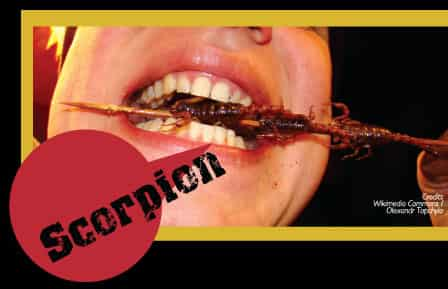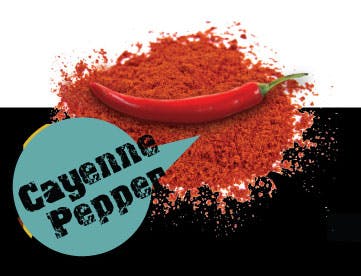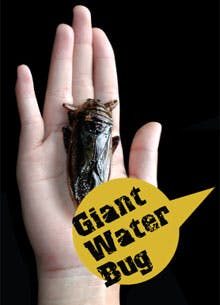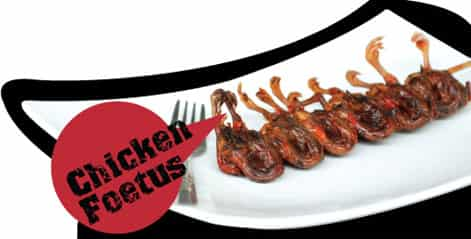
Thailand is home to some very strange foods, including bugs, blood and babies (animal babies, that is). But even the most audacious of eaters may not know the health risks and benefits behind foods that squawk, squirm and scuttle. Here, I’ll take you on a journey through some of Thailand’s most vexing victuals. Taste at your own risk!


Credits Wikimedia Commons / Istolethetv
Scorpion
Not far off on the creepy-looking creature scale is the scorpion. While many blogs and forums post cyber-worries about consuming scorpion venom, in reality, a rare few of the 1,500-plus species are deadly to humans. That said, any seasoned scorpion scarfer should take care to lop the tail off first (just like you would remove the fangs of a poisonous tarantula before eating it, right?).
Although not a popular menu item in Thai restaurants, scorpion cuisine is prevalent in markets and rural communities, and is also considered the easiest “do-or-die” food to procure if you happen to find yourself stranded in a desert (which luckily in Thailand, you won’t).
If being chockfull of protein, fat and minerals doesn’t sell you on scorpions, beginners can find curry and barbeque flavoured ones at more exotic Thai markets—apparently they taste like a bit like crab. But if scorpions do happen to be your jam (dibs on the patent for scorpion jam!), harder-to-find eccentricities like “giant water scorpion paste for cooking” can be purchased online.

Cayenne Pepper
Phet is nothing new in Thailand. In fact, it’s a staple in most dishes (what’s red curry without the red?). But for the spice-wary, a little background check on the curry culprits might allay apprehensions or even encourage you to pop back some of the world’s hottest peppers.
Cayenne, the pepper adorning most Thai market stalls and kitchen tables, is a natural remedy for many ailments due to an active ingredient called capsaicin (the “spice factor” in most peppers). According to a myriad of medical studies, not only is cayenne pepper used to pacify “painful joints, toothaches and frostbite (not likely to be an imminent fear in Thailand),” but if you happen to take a tumble motor biking in the mountains (more likely to be an imminent fear in Thailand), applying cayenne directly to the wound “can stop bleeding as well as reduce inflammation and discomfort.”
Oddly enough, cayenne is quite the ambidextrous pepper when it comes to reducing and inducing blood flow; capsaicin is also known as an unrefined Viagra because of its “vasodilation” properties. Ingesting cayenne encourages widening of blood vessels, which in turn propagates increased blood flow through the body, all the way down to…well, you can fill in the rest.

Giant Water Bug
Although Westerners (myself included) may cringe at the thought of exoskeletons, spindly legs and three sets of eyes being “the future of food,” there is a valid argument for the health and sustainability benefits of entomophagy, otherwise known as the “art” of eating insects.
Among the more popular items sold at Thai markets – including crickets, fireflies and bamboo worms – is one of Thailand’s heartiest (and healthiest) of crunchy critters – the giant water bug. Sure, they can grow up to 12 centimetres long and supposedly have one of the most painful bites in the world, but why not bite right back?
Underneath that flat, black back you can find more nutrients than a health supplement store. Aside from being crammed full of iron, calcium and protein, water bugs are rich with unsaturated fats (colloquially, “healthy fats”). Also known as “toe-biters,” water bugs contain tryptophan and lysine, two essential amino acids unable to be produced naturally by the human body. Talk about hitting all the food groups in one swoop…er…scuttle.


Snake’s Blood
Why is it that most so-called aphrodisiacs are on the appalling end of the food scale? Alongside anomalous rituals rumoured to heighten a man’s libido (of course it’s always the men doing these things), like eating buffalo womb or dried tiger penis, is a popular phenomenon in countries like Thailand and Vietnam – slitting live snakes open and drinking their blood.
Medical professionals offer zero empirical evidence showing that snake’s blood actually does anything to a man’s libido, but that hasn’t deterred traditionalists who see (or feel) evidence in more “spiritual” terms. Sure, some (mostly farang) end up swigging snake blood because they lost a bet or are maybe looking to win one, but traditionally it is consumed for therapeutic purposes (side note: U.S. troops recently drank snake blood for a Cobra Gold survival exercise in the jungles of northern Thailand).
Poisonous snakes, especially cobras, supposedly “have more effective blood,” which is even more potent while the snake is still alive. Even though there are some theories out there hypothesising a correlation between snake blood and the reduction of stress hormones in the human heart, I would draw my own hypothesis that – like most other odd aphrodisiacs – drinking snake blood triggers nothing more than a phallic placebo effect.

Chicken Foetus
Scrambled eggs. Why not? Chicken wings. Bring em’ on! Chicken foetus shish kabobs? Umm…
Famous in the Philippines, this repulsive (to a farang like I, at least) dish is known as balut, and is essentially a partially or fully formed chicken or duck foetus still in (or partially poking out of) its shell.
Thailand has its own version of balut, just without the egg. In a bustling market just outside Chiang Mai, you can purchase a skewer of chicken foetuses for only 20 baht. Yes, I eat chicken, so I will concede to being a hypocrite, but there was something about impaling chicken abortions that just didn’t sit right with me. I had to wonder – while observing with a sort of horrid fascination the bony, featherless creatures, their eyeless black sockets staring into my soul (I swear!) – what’s the point?
The market vendor claimed they were aroi, and advised me that they were best barbequed, then eaten whole (Warning! Choking hazard. Not suitable for small children). If you love food that’s extra crunchy, have at it, but if you’re opposed to choking on malleable bones, sharp beaks or a stray feather, you might want to take an egg out of my basket and hold out for one of the adults.

Credits Wikimedia Commons / Olexandr Topchylo
Water Monitor Lizard
Considering the volume of Buddhists in Thailand (especially in Chiang Mai) I was a little shocked to hear of an animal so ubiquitously hated across the Land of Smiles. The water monitor lizard (frequently referred to as hia, an obscenity in Thai that nonverbally equates to giving the middle finger) descends from the same family as the largest lizard in the world, the Komodo dragon. Though much smaller (and certainly less aggressive) than the deadly Komodo, a monitor lizard can grow longer than two metres and weigh over 100 pounds.
Dubbed by the Bangkok Post as Thailand’s “Most hated lizard to become handbags,” it is not uncommon for these unlucky fellows to be wrangled, tied up and barbequed alive. Even though the Convention on International Trade in Endangered Species (CITES) “does not permit commercial trade of wild specimens of this species,” there is no law against having a good old water monitor cook-off.
That said, masticating great clumps of six-foot long lizard with skin like gravel is not exactly the most popular of Thai dinner options.


Dog Meat
From beaches to streets to tipped-over garbage bins, there is no shortage of dogs in Thailand. As common as the geckos that dot walls and ceilings everywhere, even the most destitute of strays can expect an occasional pat or treat from passersby – that is, unless said passersby happens to be members of the “dog meat mafia.”
Though dognapping is illegal in Thailand, the dog meat market continues to skyrocket as both pet dogs and strays are nabbed from yards or streets and sold across neighbouring borders. While Westerners and Thais alike may be horrified at the prospect of eating dog (isn’t that kind of like eating your child?), dishes such as Poodle Pasta and Shih Tzu Soup remain popular in places like Vietnam, Korea and China.
John Dalley, Volunteer VP of the Soi Dog Foundation in Phuket, described disturbing details from investigative footage of “dog factories” where dogs were hung from nooses and beaten, set on fire, and even skinned and boiled alive. Apparently this helps “tenderise the meat.”
In addition to these horrors, research by nutritional physiologist Irwin Putzkoff has shown that when exposed to “stress, fear or pain,” sentient animals like dogs produce hormones linked to diseases including cardiac problems and impotency in the humans that eat their meat. Results from a rather grotesque experiment conducted by Putzkoff show laboratory rats that were fed dog meat containing high levels of fear hormones “suffered a reduction in the size of their sex organs.”
So, even if the thought of torturing a meek, wide-eyed pup doesn’t bother you too much, I hope a good case of “small balls” is enough to deter you from downing Dalmatians.

Shark Fin
Typically a Chinese tradition, the ever-controversial shark fin soup is still found in abundance across Thailand. Despite actions from campaigns like Fin Free Thailand, shark fin continues to be a staple “delicacy” among the elite and prestigious, and is commonly served at large-scale celebrations such as weddings.
Why should you avoid eating shark fin? First of all, it’s unethical. In order to produce the soup, endangered sharks are often inhumanely finned alive and tossed back into the ocean, where they drown because without their fin they cannot swim, hunt or survive.
Secondly, it’s not healthy. According to Seamas McCaffrey, campaign coordinator of Fin Free Thailand, samples from randomly selected shark fins in markets around Bangkok all came back with “higher than safe levels of mercury, with one fin even testing at 42 times the recommended safe level of mercury ingestion.” Excessive quantities of mercury can have devastating effects on the human body, including neurodegenerative diseases like Lou Gehrig’s disease, Alzheimer’s, central nervous system problems and reproductive organ problems.
Health and ethical concerns aside, shark fin soup has grown popular in countries like Thailand because of the cheapness and availability of the product, thanks to reduced labour costs. There are even restaurants in Chiang Mai (we shan’t name any because we don’t want to promote them) where shark fin soup can be had for around 500 baht – a steal compared to places in China that sell bowls for up to $200.
Although Thailand only accounts for approximately two percent of shark fin imports, McCaffrey explained that “two percent of 100 million sharks killed every year is still a lot – it’s two million sharks.” Thankfully, progress is being made, and many hotels – including the Four Seasons Chiang Mai – have signed on to Fin Free’s “Blue List” of establishments that support eradicating shark fin from menus.
Links: Fin Free’s Blue List http://www.finfreethai.org/#!blue-list/c1mhj
